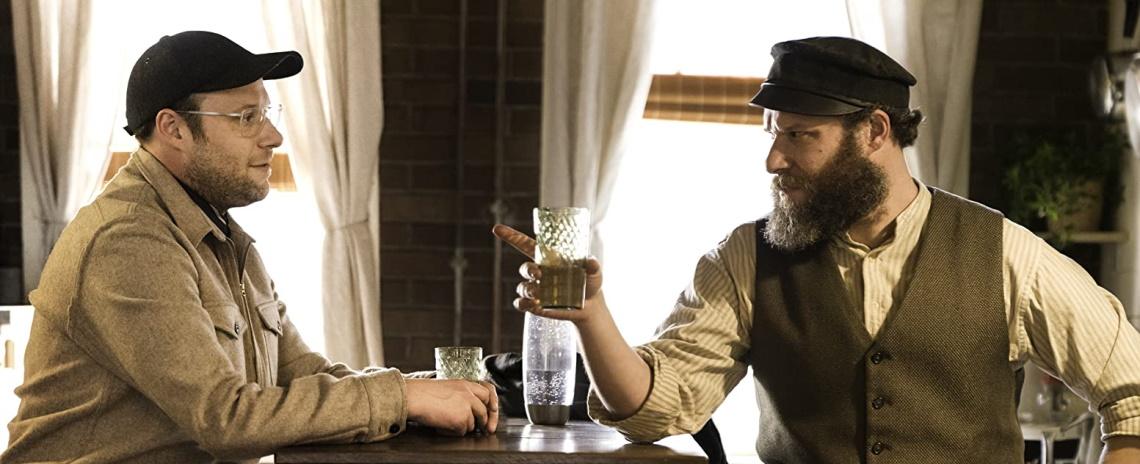Almost everyone has been in a pickle, so to speak, but very few can say that they’ve literally been encased in a pickle barrel. In all likelihood, Herschel Greenbaum (Seth Rogen), a humble Jewish laborer who fell into a vat of brine in 1919 and remained sealed inside there for a century, is probably the only person who can say such a thing. Sure, it’s an unbelievable scenario, but the new HBO Max original An American Pickle is not interested in explaining the science behind Herschel’s miraculous (and salty) preservation. This is a modern fairy tale — an absurdist and easygoing story about family, religion, labor, capital, and (somewhat unexpectedly) cancel culture that never digs that deep or lingers in one place for too long.
Originally the subject of Simon Rich’s (Man Seeking Woman) short story “Sell Out” and now one of two main characters in cinematographer-turned-director Brandon Trost’s film, Herschel Greenbaum toiled hard at his job as a ditch digger in his fictional Eastern European home country of Schlupsk. One afternoon, Herschel spots Sarah (Sarah Snook). From the moment he spies her purchasing fish from across the market, he knows she’s going to be the one. Their love blooms, as do their plans for their shared future. She wants to afford her own tombstone and grave plot, he wants to be wealthy enough to drink seltzer water, and they both want to build a legacy that transforms the Greenbaum name from lowly and locally known to rich and famous. When an ambush by Russian Cossacks leaves their shtetl in shambles, the two are forced to immigrate to America. Yet, despite the tragedy that destroyed their town, the move is a net positive for the Greenbaums: Now in the Land of Opportunity, Herschel takes a job at a Brooklyn pickle factory to help fund their dreams.
With a rat infestation dooming the factory to condemnation, Herschel falls from the rafters and lands in one of the massive tubs of brine as it’s being covered. It’ll be 100 years before he’ll see Brooklyn again but mere hours before he’s reunited with his kin. Although his wife, son, grandson, and great-grandson are all long gone, his great-great-grandson Ben (also Rogen) is alive and well ... and living in Brooklyn. The two Greenbaums — bound by blood but separated by 10 decades of history and innovation — enjoy exploring the neighborhood and the novelties that come with the contemporary world (namely Ben’s SodaStream). However, they soon find themselves more divided by their differences in outlook. Not only do their definitions of success vary greatly, but their feelings toward Judaism and the intrinsic values of the Greenbaum DNA also deepen the chasm that forms between the pair.
An American Pickle’s relatively tame PG-13 rating isn’t the only thing that sets the film apart from your typical Seth Rogen-Evan Goldberg production. There’s also Rich’s screenplay, which drops the dimwitted-stoner routine in exchange for something charmingly surreal, and John Guleserian’s cinematography, which makes An American Pickle look like a real movie with a real budget (a refreshing departure from mainstream studio comedy’s usual cheap sitcom aesthetic). Rich’s television work has always been able to carve out a nice niche for itself, with Man Seeking Woman (2015-17) garnering a cult following almost immediately and his TBS comedy Miracle Workers (2019- ) continuing to hold onto a small but loyal audience as it prepares for its upcoming third season. There’s plenty that suggests this feature film will please fans and newcomers alike. Guleserian could have easily phoned it in, simply placing the camera in one spot and letting the actors improvise their way through the scenes, as many cinematographers choose to do with modern comedies. Instead he makes An American Pickle look quite remarkable, especially in the early scenes in Schlupsk, which often mimic the visuals of a Pawel Pawlikowski film.
Director Brandon Trost has been involved with numerous idiosyncratic comedies over the past decade or so. He served as the director of photography for Jorma Taccone’s instant classic MacGruber (2010) and went on to shoot seminal ’10s comedies like This Is the End (2013) and Popstar: Never Stop Never Stopping (2016). (He’s also lensed some notably underrated dramatic works like Marielle Heller’s films The Diary of a Teenage Girl [2015] and Can You Ever Forgive Me? [2018].) Accordingly, his involvement with this film is certainly not surprising. An American Pickle is a hybrid of the kinds of projects he’s been attracted to before: a unique comedy and a peculiar drama in one. This combo allows the film to touch on serious topics without ever getting too heavy, effectively toeing the line between slight and significant.
Feeling reminiscent of other fish-out-of-water fantasies like Hal Ashby’s Being There (1979), Larry Charles’ Borat (2006), and Jon Favreau’s Elf (2003), An American Pickle is frequently funny and just as often compelling. Even when the narrative occasionally drags, the desire to see where the erratic storyline will take the characters maintains the viewer’s interest. With the bulk of Snook’s role confined to the first 15 minutes and no other big names or cameos present, this really is Rogen’s vehicle. Don’t take that the wrong way, though: With no weed jokes, very little (if any) raunchy comedy, and a total lack of the loose, improvisational atmosphere that characterizes many of his films, Rogen’s dual performance in An American Pickle represents the actor’s most authentic work in years. Granted, it’s not the most substantial or important film of the year — especially with the rest of HBO Max’s catalog just a few clicks away — but there’s enough appeal in its brief running time to make An American Pickle worth streaming.
Rating: B
An American Pickle is now available to stream from HBO Max.


